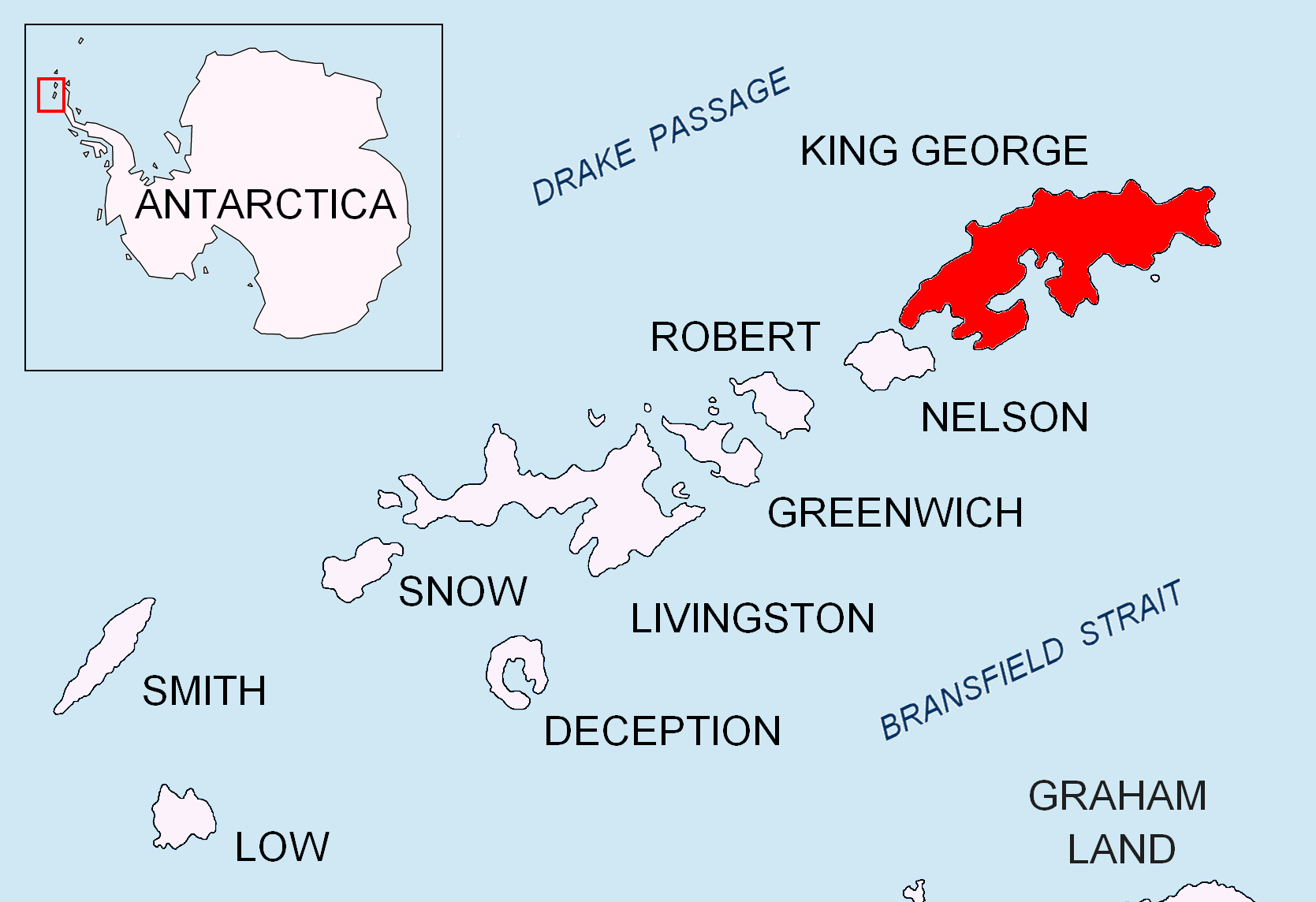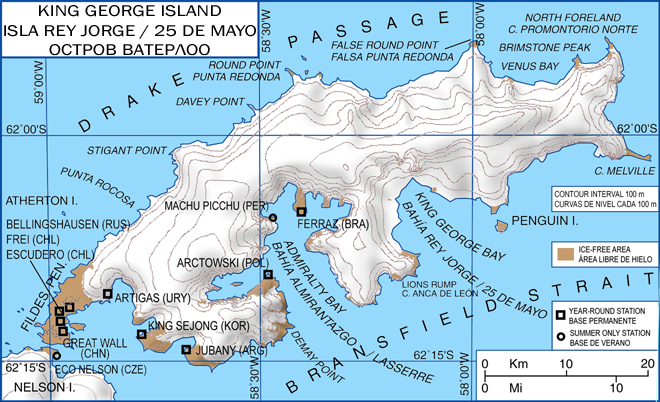|
Profound Lake
Profound Lake or Lake Profound () is a lake northwest of Jasper Point Jasper Point () is the northeastern entrance point to Norma Cove Norma Cove () is a cove between Suffield Point and Jasper Point, Maxwell Bay, King George Island. The feature was named " Bukhta Norma" or " Norma Inlet" by L.S. Govorukha and I.M ... in northeast Fildes Peninsula, King George Island. The feature was named "Ozero Glubokoye" (deep lake) by the Soviet Antarctic Expedition working from Bellingshausen Station from 1968, but both forms of the name are already in use in the Antarctic. The United Kingdom Antarctic Place-Names Committee (UK-APC) amended the name in 1979 to avoid duplication. Also known as Lago Uruguay or Uruguay Lake, it is the lake closest to the Uruguayan scientific station Artigas Base and is therefore used as a water source for the station. References * Profound Bodies of water of King George Island (South Shetland Islands) Profound {{KingGeorgeIslandAQ-geo-stub ... [...More Info...] [...Related Items...] OR: [Wikipedia] [Google] [Baidu] |
Fildes Peninsula
The Fildes Peninsula is a long peninsula that forms the south-western end of King George Island in the South Shetland Islands of Antarctica. It was named from association with nearby Fildes Strait by the UK Antarctic Place-Names Committee in 1960; the strait was likely named for Robert Fildes, a British sealer of the 1800s. Description The peninsula is the most extensively snow-free coastal area in summer on the island, most of which is permanently covered by ice. Its southeastern end is a point called Halfthree Point. It was charted and named by Discovery Investigations personnel on the ''Discovery II'' in 1935. It is part of the Fildes Peninsula Antarctic Specially Protected Area (ASPA 125), designated as such because of its paleontological values. It is separated at its tip from Nelson Island by Fildes Strait, only 370 m wide at its narrowest. It is bounded on its south-east coast by Maxwell Bay, which is also known as Fildes Bay, and on its north-west by the open wa ... [...More Info...] [...Related Items...] OR: [Wikipedia] [Google] [Baidu] |
King George Island (South Shetland Islands)
King George Island (Argentinian Spanish: Isla 25 de Mayo, Chilean Spanish: Isla Rey Jorge, Russian: Ватерло́о Vaterloo) is the largest of the South Shetland Islands, lying off the coast of Antarctica in the Southern Ocean. The island was named after King George III. Geography King George island has three major bays, Maxwell Bay, Admiralty Bay, and King George Bay. Admiralty Bay contains three fjords, and is protected as an Antarctic Specially Managed Area under the Protocol on Environmental Protection to the Antarctic Treaty. History The island was first claimed for Britain on 16 October 1819, formally annexed by Britain as part of the Falkland Islands Dependencies in 1908, and now as part of the separate British Antarctic Territory. The Island was claimed by Chile in 1940, as part of the Chilean Antarctic Territory. It was also claimed by Argentina in 1943, now as part of Argentine Antarctica, called by the Argentines ''Isla Veinticinco de Mayo'' (25 May) in ho ... [...More Info...] [...Related Items...] OR: [Wikipedia] [Google] [Baidu] |
Antarctica
Antarctica () is Earth's southernmost and least-populated continent. Situated almost entirely south of the Antarctic Circle and surrounded by the Southern Ocean, it contains the geographic South Pole. Antarctica is the fifth-largest continent, being about 40% larger than Europe, and has an area of . Most of Antarctica is covered by the Antarctic ice sheet, with an average thickness of . Antarctica is, on average, the coldest, driest, and windiest of the continents, and it has the highest average elevation. It is mainly a polar desert, with annual precipitation of over along the coast and far less inland. About 70% of the world's freshwater reserves are frozen in Antarctica, which, if melted, would raise global sea levels by almost . Antarctica holds the record for the lowest measured temperature on Earth, . The coastal regions can reach temperatures over in summer. Native species of animals include mites, nematodes, penguins, seals and tardigrades. Where vegetation o ... [...More Info...] [...Related Items...] OR: [Wikipedia] [Google] [Baidu] |
Jasper Point
Jasper Point () is the northeastern entrance point to Norma Cove Norma Cove () is a cove between Suffield Point and Jasper Point, Maxwell Bay, King George Island. The feature was named " Bukhta Norma" or " Norma Inlet" by L.S. Govorukha and I.M. Simonov, 1973, following Soviet Antarctic Expedition surveys f ..., Fildes Peninsula, on King George Island in the South Shetland Islands. The point is bounded by cliffs of black and buff rocks, in which occur veins of red and green jasper. It was so named by the UK Antarctic Place-Names Committee following geological work by the British Antarctic Survey in 1975–76. References Headlands of Antarctica {{KingGeorgeIslandAQ-geo-stub ... [...More Info...] [...Related Items...] OR: [Wikipedia] [Google] [Baidu] |
Soviet Antarctic Expedition
The Soviet Antarctic Expedition (SAE or SovAE) (russian: Советская антарктическая экспедиция, САЭ, ''Sovetskaya antarkticheskaya ekspeditsiya'') was part of the Arctic and Antarctic Research Institute of the Soviet Committee on Antarctic Research of the Academy of Sciences of the USSR. The Soviet Union's Ministry of Sea Transport was responsible for the administration, logistics and supply of the expeditions. The first Soviet contact with Antarctica was in January 1947 when the Slava whaling flotilla began whaling in Antarctic waters. Stations The first Soviet Antarctic station, '' Mirny'', was established near the coast on February 13, 1956. This was added to in December 1957 by another station, ''Vostok'' built inland near the south geomagnetic pole. Year-round stations * Mirny (established February 13, 1956) * Vostok (established December 16, 1957) * Novolazarevskaya (established January 18, 1961) * Molodyozhnaya (established January 1 ... [...More Info...] [...Related Items...] OR: [Wikipedia] [Google] [Baidu] |
Bellingshausen Station
Bellingshausen Station (Russian: станция Беллинсгаузен) is a Russian (formerly Soviet) Antarctic station at Collins Harbour, on King George Island of the South Shetland Islands. It was one of the first research stations founded by the Soviet Antarctic Expedition in 1968. It is also the location of Trinity Church, the only permanently staffed Eastern Orthodox church in Antarctica. The station is named for the 19th-century Russian explorer of the Antarctic Fabian von Bellingshausen. The station is connected by unimproved roads to the nearby stations: Chilean Base Presidente Eduardo Frei Montalva, Chinese Great Wall Station, and Uruguayan Artigas Base. It is antipodal to a location in Russian Siberia, ~400 km west from Yakutsk. In October 2018, it was the site of the first attempted murder in Antarctica. Climate The Antarctic Peninsula and its nearby islands are considered to have the mildest living conditions in Antarctica. Bellingshausen Station ... [...More Info...] [...Related Items...] OR: [Wikipedia] [Google] [Baidu] |
United Kingdom Antarctic Place-Names Committee
The UK Antarctic Place-Names Committee (or UK-APC) is a United Kingdom government committee, part of the Foreign and Commonwealth Office, responsible for recommending names of geographical locations within the British Antarctic Territory (BAT) and the South Georgia and the South Sandwich Islands (SGSSI). Such names are formally approved by the Commissioners of the BAT and SGSSI respectively, and published in the BAT Gazetteer and the SGSSI Gazetteer maintained by the Committee. The BAT names are also published in the international Composite Gazetteer of Antarctica maintained by SCAR. The Committee may also consider proposals for new place names for geographical features in areas of Antarctica outside BAT and SGSSI, which are referred to other Antarctic place-naming authorities, or decided by the Committee itself if situated in the unclaimed sector of Antarctica. Names attributed by the committee * Anvil Crag, named for descriptive features * Anckorn Nunataks, named after J. F. ... [...More Info...] [...Related Items...] OR: [Wikipedia] [Google] [Baidu] |
Artigas Base
The General Artigas Station ( es, Base Científica Antártica Artigas), also referred to as the Artigas Base is the larger of the two Uruguayan scientific research stations in Antarctica, the other one being Elichiribehety Base. It is one of the 68 bases in Antarctica. Organization The Artigas Base depends on the Uruguayan Antarctic Institute The Uruguayan Antarctic Institute ( es, Instituto Antártico Uruguayo) is Uruguay's governmental agency to fund, organize, control and promote research on Antarctica according with the Antarctic Treaty System. It was founded by scientists, and is ... Plans & Operations Direction which is ruled by an Interministerial Council, with delegates of MoD, Foreign Affairs and ministry of Education and Culture. Uruguay, a Consultative member of Antarctic Treaty since 7 October 1985, has a permanent, active and autonomous activity as a National Governmental Program in Antarctic. It comes to effect operating an all year round station in Kin ... [...More Info...] [...Related Items...] OR: [Wikipedia] [Google] [Baidu] |
Lakes Of Antarctica
A lake is an area filled with water, localized in a basin, surrounded by land, and distinct from any river or other outlet that serves to feed or drain the lake. Lakes lie on land and are not part of the ocean, although, like the much larger oceans, they do form part of the Earth's water cycle. Lakes are distinct from lagoons, which are generally coastal parts of the ocean. Lakes are typically larger and deeper than ponds, which also lie on land, though there are no official or scientific definitions. Lakes can be contrasted with rivers or streams, which usually flow in a channel on land. Most lakes are fed and drained by rivers and streams. Natural lakes are generally found in mountainous areas, rift zones, and areas with ongoing glaciation. Other lakes are found in endorheic basins or along the courses of mature rivers, where a river channel has widened into a basin. Some parts of the world have many lakes formed by the chaotic drainage patterns left over from the last ice ... [...More Info...] [...Related Items...] OR: [Wikipedia] [Google] [Baidu] |
Bodies Of Water Of King George Island (South Shetland Islands)
Bodies may refer to: * The plural of body * ''Bodies'' (2004 TV series), BBC television programme * Bodies (upcoming TV series), an upcoming British crime thriller limited series * "Bodies" (''Law & Order''), 2003 episode of ''Law & Order'' * Bodies: The Exhibition, exhibit showcasing dissected human bodies in cities across the globe * ''Bodies'' (novel), 2002 novel by Jed Mercurio * ''Bodies'', 1977 play by James Saunders (playwright) * ''Bodies'', 2009 book by British psychoanalyst Susie Orbach Music * ''Bodies'' (album), a 2021 album by AFI * ''Bodies'' (EP), a 2014 EP by Celia Pavey * "Bodies" (Drowning Pool song), 2001 hard rock song by Drowning Pool * "Bodies" (Sex Pistols song), 1977 punk rock song by the Sex Pistols * "Bodies" (Little Birdy song), 2007 indie rock song by Little Birdy * "Bodies" (Robbie Williams song), 2009 pop song by Robbie Williams * "Bodies", a song by Megadeth from ''Endgame'' * "Bodies", a song by The Smashing Pumpkins from ''Mellon Collie an ... [...More Info...] [...Related Items...] OR: [Wikipedia] [Google] [Baidu] |




